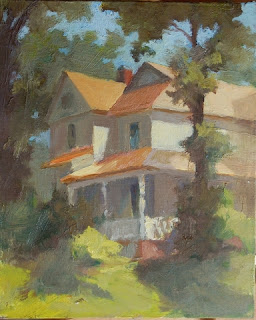Plein Air artists differ on how they view the pieces they produce outdoors. Purists consider these pieces finished art, ready to sell, while others use these paintings only as studies for larger works; the rest stand somewhere in between. I have bounced back and forth on this over time. Early on I had pretty good luck completing a painting outdoors. Here is one that I immediately knew was finished and ready to sign before I packed up my easel. Someone else agreed - it was stolen from the coffee shop where it was for sale!
When I brought unsatisfactory plein air paintings back to the studio and tried to "fix"
them, I was usually unsuccessful. Back in the studio, I was looking at a photo that didn't accurately depict what I saw outdoors and I found myself
repainting the whole thing according to the photo I had taken, ultimately wasting a canvas and a lot of time as you can see below -
YUCK! Where is the light source in this painting?!?
After taking D. Eleinne Basa's workshop in summer of 201, I tried following her good advice. She recommended not reworking plein air pieces but, instead, concentrating on capturing what is needed to produce a second painting in the studio. I did this and it does work, but something kept making me want to "fix" them!
This past summer I have done a good bit of outdoor work and found myself working on the pieces when I got them back to the studio. I feel I have been more successful than in the past by:
- Making every effort to work more slowly and deliberately outdoors, reminding myself to capture what drew me to the subject initially and get the information down that I will need to complete the piece back in the studio.
- Ceasing to work on the painting outdoors when it becomes clear to me that the light has changed too drastically or when I find myself mindlessly slapping paint or pastel on the work.
- Keeping my colors bright and clean when I am outdoors - even leaving them a bit garish to avoid the muddiness that can occur from overworking things. I can always calm them down.
- When I return to the studio I continue to paint rather than repaint - big difference!
- Viewing the photo in grayscale on my computer to avoid seeing the color differences between photo and reality - using the photo only as a reference for values.
- Adding smaller shapes and details to the paintings in the studio.
Here are a few examples - see what you think. Is is working?








